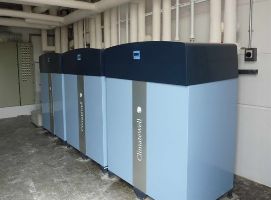Sweden: Vacuum Tube Produces Heat and Cold Depending on Day or Night
February 25, 2013
The latest development of Swedish Company ClimateWell is called CoolStore and can be integrated into a collector casing. ClimateWell offers this special vacuum tube, which produces heat or cold, to interested collector manufacturers. The former producer of absorption chillers has completely altered its product range to become a component supplier for boilers and air-conditioners for vehicles. The new product, however, has still not been entirely uncovered in the figure above, because “we do not want to disclose too much yet”, explains ClimateWell’s CEO, Per Olofsson. “The idea of the CoolStore tube is that solar cooling needs to be simpler and more efficient to really work on the market. At the same time, we also wanted lower cooling temperatures for efficient air-conditioning and dehumidification.”

The solution was simple: ClimateWell integrated the triple-stage absorption cooling cycle into an all-glass evacuated tube. This so-called CoolStore tube is a single-glass vacuum tube filled with lithium chloride (LiCl) and water. It has a hot side for the reactor where the absorption medium lithium chloride is charged, and a cold side, at which the evaporator produces around 5 °C cold water through a heat exchanger. The vacuum tube’s hot side is covered by a metal absorber with water-filled tubes in the back. This bended absorber plate, which is well-known in the collector industry, lies directly on the glass tubes. The cold side of the CoolStore tubes is shaded and surrounded by a heat exchanger. This cold side delivers tap water heating during the day and air-conditioning during the night.
In order to understand how the heating-cooling unit works, it is important to know that the CoolStore tubes are integrated into the building through three separate circuits: first the air-conditioning, then the heating and third, the re-cooling circuit. During the day, the absorber plate on the hot side reaches more than 100 °C in the vacuum tube, which directly starts the absorption process. At the same time, the condenser on the cold side is only some 40°C warm – warm enough, however, to heat the building or the tap water. If the hot water is not used, it will be sent to the re-cooler. When the hot side cools down at night, the cold side goes down to cooling temperatures as far as 5°C. The hot side, however, is now some 40°C warm and can be used to heat the tap water. If the hot water is not used, it will be sent to re-cooling again. In short: The dry LiCl works as an energy storage, which makes air conditioning possible during the night and heating during both day and night.
According to Olofsson, there are a number of advantages when working with this type of system: Integrating the solar heating and cooling unit into the collector on the roof simplifies installation and piping work and – most important – reduces thermal losses, which also means lower air conditioning temperatures. The CEO emphasises that the re-cooler is less critical because losses are much smaller, allowing it to be used with a dry cooler or a swimming pool. There is one disadvantage, however: The lack of cooling power during the day makes a cold storage necessary in most cases.
“We have extensive experiences with simulating and measuring the CoolStore tubes, which allows us to offer solar thermal collector manufacturers the full package, including samples of CoolStore tubes, as well as technical support from our senior engineering team,” explains Olofsson. “We talk with them about all sorts of cooperation. Either they purchase the CoolStore tubes and manufacture their own panels with them, or they buy the fully assembled collector and sell it under their own brand.”
More information:
http://www.climatewell.com
CoolStore@climatewell.com


